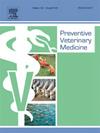利用随机模型模拟评估牛结核病替代监测措施的成本效益
IF 2.2
2区 农林科学
Q1 VETERINARY SCIENCES
引用次数: 0
摘要
为了应对自2010年以来在法国观察到的牛结核病感染率不断上升的情况,国家当局正在考虑在强化筛查区(定义为距离牛结核病暴发 公里或10公里范围内的城市)对牛结核病采取替代监测措施。本研究的目的是利用随机经济和流行病学模型模拟,从农民支出的角度,确定目前对位于加强筛查区(RSA)的法国乳制品、牛肉和小型(10头)农场实施强制性监测方案的三种替代方案的成本效益。这些替代措施包括降低年度筛查计划(M1)的bTB最低筛查年龄,在动物运动前进行系统的bTB筛查(M2),以及在bTB阳性检测(M3)后进行干扰素-γ检测(INF-γ),而不是严格的检疫和死后诊断。我们表明,实施M1和M2分别增加了每个农场6欧元至828欧元和56欧元至647欧元的年度成本,而实施M3导致每个农场平均每年成本降低3欧元至352欧元。这些减少与被扑杀用于死后诊断的动物减少以及农场检疫或被排除在国际市场之外的可能性降低有关。我们还表明,在RSA农场中使用这三种替代措施的组合可能导致每年发现11到17例额外的bTB暴发。一套极具成本效益的措施是,在实施M2和M3的同时,将M1保持在24个月前。该战略每个农场的年平均成本为209欧元,与基线方案相比,每年可多发现11起结核病疫情。要发现更多的结核分枝杆菌疫情,最大限度地减少额外发现结核分枝杆菌疫情的边际成本,最具成本效益的政策是在14个月时确定M1,同时实施M2和M3。采用这种方法,每个农场的年平均费用为352欧元,每年可发现15起额外的结核病疫情。综上所述,通过模拟随机模型评估替代监测措施可以帮助决策者实施监测政策,平衡疾病监测成本和健康结果。目前的工作支持采用M1、M2和M3,并将年度检测的最低筛查年龄降至14个月。本文章由计算机程序翻译,如有差异,请以英文原文为准。
Cost-effectiveness assessment of alternative surveillance measures for bovine tuberculosis using stochastic modeling simulation
To respond to the increasing bovine Tuberculosis (bTB) infection rates observed in France since 2010, national authorities are considering alternative surveillance measures for bTB in Reinforced Screening Areas, defined as municipalities within 5 or 10 km range of a bTB outbreak. The objective of this study was to determine the cost-effectiveness, from the farmer expenses point of view, of three alternatives to the current mandatory surveillance scenario applied on French dairy, beef and small (<10 heads) farms located in Reinforced Screening Areas (RSA), using stochastic economic and epidemiologic modeling simulation. These alternative measures include reducing bTB minimum screening age for the annual screening program (M1), systematic bTB screening before animal movement (M2), and performing an interferon-gamma test (INF-γ) instead of strict quarantine and post-mortem diagnosis after a bTB positive test (M3). We show that the implementation of M1 and M2 increases annual costs ranging from €6 to €828 per farm and from €56 to €647 per farm, respectively, whereas the implementation of M3 led to average annual cost reductions between €3 and €352 per farm. These reductions were linked to fewer animals culled for post-mortem diagnostic and to a lower probability of farm quarantine or exclusion from the international markets. We also show that using a combination of the three alternatives measures in RSA farms could lead to detect between 11 and 17 additional bTB outbreaks per year. A highly cost-effective set of measures is to keep M1 at 24 months old while implementing M2 and M3. This strategy has an average annual cost of €209 per farm and allows to detect 11 additional bTB outbreaks per year compared with the baseline program. The most cost-effectiveness policy to detect more bTB outbreaks, minimizing the marginal cost of additional bTB outbreak detection, is to establish M1 at 14 months while implementing M2 and M3. This approach had average annual cost of €352 per farm and allowed to detect 15 additional bTB outbreaks per year. As a conclusion, the assessment of alternative surveillance measures through simulation stochastic models could assist policymakers to implement surveillance policy that balances disease monitoring costs and health outcomes. The present work supports the adoption of M1, M2 and M3 and reducing the minimum screening age at annual testing to 14 months.
求助全文
通过发布文献求助,成功后即可免费获取论文全文。
去求助
来源期刊

Preventive veterinary medicine
农林科学-兽医学
CiteScore
5.60
自引率
7.70%
发文量
184
审稿时长
3 months
期刊介绍:
Preventive Veterinary Medicine is one of the leading international resources for scientific reports on animal health programs and preventive veterinary medicine. The journal follows the guidelines for standardizing and strengthening the reporting of biomedical research which are available from the CONSORT, MOOSE, PRISMA, REFLECT, STARD, and STROBE statements. The journal focuses on:
Epidemiology of health events relevant to domestic and wild animals;
Economic impacts of epidemic and endemic animal and zoonotic diseases;
Latest methods and approaches in veterinary epidemiology;
Disease and infection control or eradication measures;
The "One Health" concept and the relationships between veterinary medicine, human health, animal-production systems, and the environment;
Development of new techniques in surveillance systems and diagnosis;
Evaluation and control of diseases in animal populations.
 求助内容:
求助内容: 应助结果提醒方式:
应助结果提醒方式:


